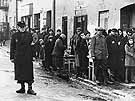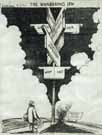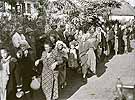
|
|
|

|

|

|

|
|
Click on an image to see a larger, more detailed picture.
|
|
|
|
|
| 1941: Mass Murder |

|
pg. 216 |

|
|
|
|
| |
 Residents of the Lódz (Poland) Ghetto stare at a Jewish policeman--seemingly with contempt. The Jewish councils established their own police forces to patrol the ghettos and maintain order. These policemen had to cooperate with the Nazis, but in return they received increased rations and special privileges--for themselves and their families. These advantages often meant the difference between life and death.
Residents of the Lódz (Poland) Ghetto stare at a Jewish policeman--seemingly with contempt. The Jewish councils established their own police forces to patrol the ghettos and maintain order. These policemen had to cooperate with the Nazis, but in return they received increased rations and special privileges--for themselves and their families. These advantages often meant the difference between life and death.
Photo: Bildarchiv Preussischer Kulturbesitz
|
 A cartoon from the North-China Daily News portrays the plight of Jewish refugees. With emigration to Palestine greatly limited by the British and entrance into North America slowed to a trickle, European Jews scattered around the globe. Thousands of Jews made their way to Shanghai, where the Chinese government created a benevolent ghetto for the recent arrivals from Europe.
A cartoon from the North-China Daily News portrays the plight of Jewish refugees. With emigration to Palestine greatly limited by the British and entrance into North America slowed to a trickle, European Jews scattered around the globe. Thousands of Jews made their way to Shanghai, where the Chinese government created a benevolent ghetto for the recent arrivals from Europe.
Photo: Lutz Haase/ United States Holocaust Memorial Museum Photo Archive
|
 The Holocaust in Romania
The Holocaust in Romania
Romania was among the most antisemitic countries of prewar Europe. Once war began, the continuing persecution of Romania's Jews culminated in mass murder. Romanian troops rivaled Nazi Einsatzgruppen in the brutal killing of Jews, annihilating half of Romania's prewar Jewish population of 760,000. During the 1930s, economic depression fueled Romanian propaganda that depicted Jews as parasites. Stringent laws stripped Jews of civil rights. In January 1941 Iron Guard Legionnaires stormed the Jewish section of Bucharest, where they burned shops, homes, and synagogues. Thousands of Jews were beaten and tortured. Some Jews were herded into a slaughterhouse and literally butchered according to Jews' own ritual practices of animal slaughter. The bodies were hung on meat hooks and displayed with "Kosher meat" labels. The German invasion of the Soviet Union sparked further pogroms. In the recaptured Romanian provinces of Bukovina and Bessarabia, Jews bore the brunt of the killing frenzy. Over 250,000 perished there through mass shootings, through drowning in the Dniester River, or from starvation and disease within ghettos and slave-labor camps. During the siege of Odessa, Romanian dictator Ion Antonescu ordered the execution of more than 35,000 of the city's Jews. Einsatz squads even complained of the Romanian soldiers' "undisciplined killing zeal," particularly their disregard for the disposal of corpses.
Photo: Bundesarchiv / United States Holocaust Memorial Museum Photo Archive
|
|

|

|

|

|
 January 30, 1941: On his eighth anniversary as chancellor, Hitler repeats his threat to destroy all of the Jews of Europe.
January 30, 1941: On his eighth anniversary as chancellor, Hitler repeats his threat to destroy all of the Jews of Europe.
|
 January 31, 1941: 3000 Jewish deportees, mostly from the Polish town of Pruszków, arrive at the Warsaw Ghetto.
January 31, 1941: 3000 Jewish deportees, mostly from the Polish town of Pruszków, arrive at the Warsaw Ghetto.
|
 Early 1941: The population of the Warsaw Ghetto swells to 400,000. Jewish residents are limited to 183 calories a day (Germans are allowed 2310 a day; foreigners 1790; Poles 934).
Early 1941: The population of the Warsaw Ghetto swells to 400,000. Jewish residents are limited to 183 calories a day (Germans are allowed 2310 a day; foreigners 1790; Poles 934).
|
 January-March 1941: 70,000 displaced Polish Jews are forced into the Warsaw Ghetto.
January-March 1941: 70,000 displaced Polish Jews are forced into the Warsaw Ghetto.
|
|
|
|
|
| 1941: Mass Murder |

|
pg. 216 |

|
|
The Holocaust Chronicle
© 2009 Publications International, Ltd.
|
|
